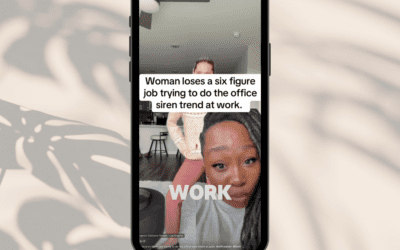If you’ve spent five minutes on TikTok lately, you’ve probably come across the office siren trend. It’s a glossy mashup of late '90s power dressing and late 2000s clubwear. Satin pencil skirts, sultry tops, moody liner, tousled hair, and “main character at the copy...
The Untapped Goldmine: How Social Media Is Winning With the 60+ Crowd
If you’re still thinking of social media as a space dominated by teens and twenty-somethings, you’re missing one of the most engaged, loyal, and financially powerful audiences out there: adults over 60.
This isn’t just a feel-good insight. It’s backed by real numbers, real behavior, and real success like the campaign we’re running right now for a brand focused entirely on this demographic.
They’re a publication and book centered around retirement, aging well, travel, health, and longevity. And since partnering with us, their presence on social media, particularly on Facebook, has completely transformed. Not because we boosted a few posts and crossed our fingers. But because we built a strategy grounded in understanding how this generation actually uses social media.
Here’s what that looked like, and why this demographic deserves more attention from brands of all sizes.
Why Facebook Still Matters
There’s a lot of noise in the digital space about Facebook being “over.” But for the 60+ crowd, it’s not just alive, it’s where their digital lives are happening.
Roughly 70% of adults aged 50–64 and 59% of those over 65 use Facebook regularly, according to Pew Research. And they’re not just logging in passively. AARP’s 2024 survey showed that 72% of people 50+ use Facebook to stay connected, consume news, and engage with communities. They’re checking in daily, often multiple times, to participate in Groups, leave comments on family photos, and click through on content that feels relevant to their stage of life.
And that’s the key: relevance.
This demographic isn’t chasing trends, they’re looking for value. They want information, meaningful conversation, and updates that help them navigate everything from managing their health to making retirement decisions.
The Strategy We Built (And Why It Worked)
When this client came to us, they were posting semi-regularly, getting a few comments, and running the occasional boosted post. The problem was their content wasn’t hitting the mark, and their audience,who was out there, wasn’t engaging.
So we threw out the one-size-fits-all playbook and started with a ground-up strategy focused on intentionality. That included three major shifts.
1. Ads Run Through Meta Properly—Not Just Boosts
We don’t boost posts. We use Meta’s full ad suite to build custom audiences, test creative variations, and run structured campaigns that speak directly to the user journey. More than that, we’ve taken the training Meta provides advertisers like us and work directly with Meta pros to optimize our ads.
This matters because Meta’s tools allow us to refine delivery and tailor our messaging for the 60+ user, instead of relying on generic interest-based targeting. For this campaign, we focused on warm audiences. Those already familiar with the publication and then expanded reach through thoughtful retargeting and content that reflected their interests and concerns.
Research supports this approach: click-through rates on Meta platforms are actually higher among adults 55+ than they are for younger users. A study by Pixability found that users aged 65+ had a 3.42% CTR on Facebook video ads, nearly triple that of 18–24-year-olds. And older women, in particular, engage even more when they see relatable content that features people their own age.
Which brings us to the next point.
2. We Created Content That Reflected Real Life
Forget stock photos of seniors smiling at salads. We leaned into content that felt personal, useful, and clear. Storytelling over selling. We talked about financial anxiety without fear-mongering. We covered wellness topics without dumbing them down. And we used photography that actually reflected the audience: older adults living real, vibrant lives.
Research from Meta and CivicScience backs this up: ads that feature people 50+ performing everyday tasks perform significantly better with this demographic than ones featuring younger models. In one A/B test, older adults were 125% more likely to click on an ad when the creative included someone their age.
In other words, when you show up with content that actually sees them, they engage.
3. Consistency, Without the Noise
We didn’t overpost. We didn’t disappear. We developed a steady rhythm that kept the brand visible without overwhelming people’s feeds. That predictability builds trust.
A major misconception is that older adults are passive online. But studies show otherwise. Nearly half of all adults 65+ spend over an hour per day on social media, and Boomers spend an average of 90 minutes daily on social platforms. The difference is in how they use it: for them, it’s about community, not entertainment. They’re less likely to chase trends and more likely to engage when something feels useful or familiar.
Over time, we noticed that followers began showing up in the comments regularly. They responded to newsletter prompts, shared thoughtful reactions, and engaged in meaningful ways. It wasn’t a fluke. It was the result of building a relationship, post by post.
Misconceptions That Need to Go
Plenty of brands assume older adults don’t use social media. Or that they can’t figure it out. Or that they’re too set in their ways to care about a brand’s content.
None of that holds up when you look at the data.
Let’s break it down:
- They’re online. Nearly 90% of adults over 65 are internet users, and 74% of people over 50 use social media regularly.
- They’re multi-platform. While Facebook leads, YouTube is just as dominant—used by 65% of seniors and 86% of people aged 50–64. And yes, many are on Instagram, Pinterest, and even TikTok.
- They click. Ads targeted to the 60+ crowd often see better click-through rates than those aimed at younger audiences.
- They convert. In 2024, over 22 million Americans aged 55+ made a purchase through social media.
- They stick around. Older adults tend to be more brand-loyal and less likely to jump from one trend to another. When you earn their trust, you keep it.
What This Means for You
If your business serves people over 60, or if it could, you might be sitting on a massive opportunity.
This demographic is growing fast. They’re spending time online every day. They have disposable income, decision-making power, and a real hunger for meaningful content. What they don’t have time for is gimmicks or one-size-fits-all messaging.
If you’ve been overlooking this audience because you thought social media “wasn’t their thing,” it’s time to reframe the conversation. Because not only are they here, they’re thriving. They’re looking for information that matters, stories that reflect their lives, and brands that show up consistently.
That’s what we’ve built with this client, and the results speak for themselves.
Let’s Build Something That Works
At Monarch, we don’t believe in social media for the sake of it. We believe in strategy. And we’ve seen what happens when you stop talking about older adults and start talking to them. So if you’re a clinic, a financial service, a wellness brand, a lifestyle product, or a purpose-driven business looking to reach this audience, we’re ready when you are.
Book a discovery call and let’s talk about what you’ve been missing, and what’s waiting when you get it right.
Case Study: How a GTA Sports Medicine Clinic Increased Local Bookings and Visibility with Strategic Social Media
If you're running a healthcare or sports medicine clinic, you already know how competitive the landscape can be, especially in busy urban areas like the Greater Toronto Area (GTA). Standing out requires more than excellent services. It demands a strong digital...


